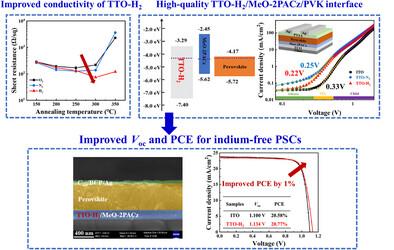Tantalum-Doped Tin Oxide Films with Post-Annealing in H2 Strategy Enabling Improved Performance of Indium-Free Perovskite Solar Cells
IF 12.1
2区 材料科学
Q1 CHEMISTRY, MULTIDISCIPLINARY
引用次数: 0
Abstract
Indium tin oxide (ITO) films are widely used as transparent electrodes in perovskite solar cells (PSCs). However, the limited supply and high cost of rare indium pose challenges to the sustainable development of PSCs. In this study, sputtered tantalum-doped tin oxide (TTO) films with post-annealing in H2 (TTO-H2), are proposed as an attractive alternative to ITO electrodes in PSCs. It is demonstrated that TTO films post-annealed in H2 atmosphere exhibited lower sheet resistance of 91.8 Ω sq−1, with a higher carrier concentration of 6.51 × 1020 cm−3, and a higher mobility of 6.96 cm2 V−1 s−1, compared to TTO films post-annealed in O2 and N2 atmospheres. The mechanism behind the improvement in electrical characteristics is revealed. Indium-free inverted PSCs using TTO-H2 bottom electrodes are constructed. High-quality TTO-H2/MeO-2PACZ/perovskite interface is demonstrated with advantages of higher built-in electric field, lower defect state density, and improved carrier transport ability, compared to the reference ITO/MeO-2PACZ/perovskite interface. Thus, the prepared PSCs using TTO-H2 electrodes exhibit improved photovoltaic performance compared to reference ITO-based PSCs: the open-circuit voltage (Voc) is enhanced from 1.100 to 1.134 V; and the power conversion efficiency (PCE) is enhanced from 20.58% to 20.77% with 1% increase. This study demonstrates the indium-free PSCs with enhanced Voc and PCE for the first time, and elucidates the underlying mechanisms, providing new insights for high-performance and low-cost PSCs.

H2后退火掺杂钽氧化锡膜提高无铟钙钛矿太阳能电池性能
氧化铟锡(ITO)薄膜作为透明电极广泛应用于钙钛矿太阳能电池(PSCs)。然而,稀有铟的有限供应和高昂的成本给聚氯乙烯的可持续发展带来了挑战。在这项研究中,在H2中退火的溅射掺杂钽氧化锡(TTO)薄膜(TTO-H2)被认为是PSCs中ITO电极的一个有吸引力的替代品。结果表明,与在O2和N2气氛下退火的TTO膜相比,在H2气氛下退火的TTO膜具有较低的薄膜电阻91.8 Ω sq−1,载流子浓度为6.51 × 1020 cm−3,迁移率为6.96 cm2 V−1 s−1。揭示了电特性改善背后的机制。利用TTO-H2底电极构建了无铟倒置PSCs。与参考ITO/MeO-2PACZ/钙钛矿界面相比,高质量的TTO-H2/MeO-2PACZ/钙钛矿界面具有更高的内置电场、更低的缺陷态密度和更高的载流子输运能力。因此,与参考ito基PSCs相比,使用to - h2电极制备的PSCs具有更好的光伏性能:开路电压(Voc)从1.100 V提高到1.134 V;功率转换效率(PCE)由20.58%提高到20.77%,提高1%。本研究首次证明了无铟PSCs具有增强的Voc和PCE,并阐明了其潜在的机制,为高性能和低成本的PSCs提供了新的见解。
本文章由计算机程序翻译,如有差异,请以英文原文为准。
求助全文
约1分钟内获得全文
求助全文
来源期刊

Small
工程技术-材料科学:综合
CiteScore
17.70
自引率
3.80%
发文量
1830
审稿时长
2.1 months
期刊介绍:
Small serves as an exceptional platform for both experimental and theoretical studies in fundamental and applied interdisciplinary research at the nano- and microscale. The journal offers a compelling mix of peer-reviewed Research Articles, Reviews, Perspectives, and Comments.
With a remarkable 2022 Journal Impact Factor of 13.3 (Journal Citation Reports from Clarivate Analytics, 2023), Small remains among the top multidisciplinary journals, covering a wide range of topics at the interface of materials science, chemistry, physics, engineering, medicine, and biology.
Small's readership includes biochemists, biologists, biomedical scientists, chemists, engineers, information technologists, materials scientists, physicists, and theoreticians alike.
 求助内容:
求助内容: 应助结果提醒方式:
应助结果提醒方式:


